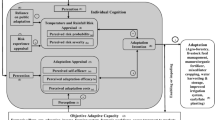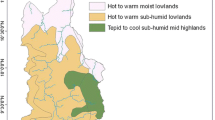Abstract
In addition to many other stressors, climate change has emerged as one of the major threats for smallholder farmers from Toumodi in the center and Korhogo in the north of Côte d’Ivoire. This study examined farmers’ adaptation behavior with respect to subjective, socio-demographic, institutional, and physical variables. Focus group discussions with 205 farmers and large-scale surveys involving 800 farmers’ households were conducted in both study areas for data collection. The data were analyzed using a categorical principal component analysis (CATPCA), reliability analyses, and binary logistic regression models to determine relevant influences on farmers’ adaptation behavior. The results revealed that 77 % of farmers perceived high increases in temperature and 75 % perceived strong decreases in rainfall over the last 10 years. Farmers in Toumodi perceived more climate change than their colleagues in Korhogo. In addition, farmers from Korhogo perceived more new pests (81 %) and new weeds (87 %), while those from Toumodi agreed that there were strong changes in flowering and fruiting times (54 %). Furthermore, two main adaptation groups were identified: changes in the sowing management and the technical itinerary. The levels of implemented strategies differed significantly across regions. Factors such as the perceived occurrence of new pests and insects and support from national and international organizations were relevant to farmers’ decision to adapt to climate change. Moreover, the agro-ecological specificities, the types of food crops, and the owners of livestock had also an influence on farmers’ adaptation choices. The appropriate policy response should henceforth integrate these factors to support efficient adaptation processes in response to climate change in Côte d’Ivoire.



Similar content being viewed by others
References
Adger N, Dessai S, Goulden M et al (2009) Are there social limits to adaptation to climate change? Clim Chang 93:335–354
Ahossane K, Jalloh A, Nelson GC et al (2013) Côte d’Ivoire, chapter 5. In West African Agriculture and Climate change: A Comprehensive Analysis. Research Monograph. International Food Policy Research Instittute (IFPRI), Washington, DC. doi:http://dx.doi.org/10.2499/9780896292048
Asfaw K, Jones J (2010) Climate change and human security in Africa. Int J Sustain Dev World Ecol 17(6):453–461
Birgit H, Bruzon V (2006) Profil Environnemental de la Côte d’Ivoire. Rapport Final. Consortium AGRIFOR Consult, p 133
Brou Y, Akindès F, Bigot S (2005) La variabilité climatique en Côte d’Ivoire: entre perceptions sociales et réponses agricoles. Cah Agric 14:533–540
Brou Y, Chaléard J (2007) Visions paysannes et changements environnementaux en Côte d’Ivoire. Annales de géographie 1:65–87
Bryan E, Deressa T, Gbetibuo G, Ringler C (2009) Adaptation to climate change in Ethiopia and South Africa: options and constraints. Environ Sci Pol 12(4):413–426
Bryan E, Ringler C, Okoba B et al (2013) Adapting agriculture to climate change in Kenya: Household strategies and determinants. J Environ Manag 114:26–35
Cissé G, Koné B, Hampaté Bâ et al. (2011) Ecohealth and Climate Change: Adaptation to flooding events in riverside secondary cities, West Africa. K. Otto-Zimmermann (ed), Resilient Cities: Cities and Adaptation to Climate 55. Change Proceedings of the Global Forum 2010, Local sustainability 1(2): 55–67
Comoé H, Finger R, Barjolle D (2012) Farm management decision and response to climate variability and change in Côte d’Ivoire. Mitig Adapt Strateg Glob Chang. doi:10.1007/s11027-012-9436-9
CountrySTAT Côte d’Ivoire (2012) Quantité des exportations des cultures et des produits de l’élevage. Retrieved June 4, 2012, from http://countrystat.org/civ/cont/inctables/pageid/8_mega/fr
Croppenstedt A, Demeke M, Meschi M (2003) Technology adoption in the presence of constraints: the case of fertilizer demand in Ethiopia. Rev Dev Econ 7(1):58–70
Deressa T, Hassan R, Ringler C, Alemu T, Yesuf M (2009) Determinants of farmers’ choice of adaptation methods to climate change in the Nile Basin of Ethiopia. Glob Environ Chang 19:248–255
Di Falco S, Marcella V, Mahmud Y (2011) Does adaptation to climate change provide food security? A microperspective from Ethiopia. Am J Agric Econ 93(3):829–846
Dje K (2008) L’impact des changements climatiques sur le climat en Côte d’Ivoire. Contribution de la SODEXAM. Communication dans le cadre du rapport Mondial sur le Developpement Humain 2007/2008. UNEP
Esham M, Garforth C (2012) Agricultural adaptation to climate change: insights from a farming community in Sri Lanka. Mitig Adapt Strateg Glob Chang. doi:10.1007/s11027-012-9374-6
FAO (2000) Etude sur la vulgarisation agricole en Côte d’Ivoire. Retrieved from http://www.fao.org/sd/FRdirect/EXre0028.htm
Field A (ed) (2009) Discovering statistics using SPSS. Sage publications, London
Gbetibouo G (2009) Understanding farmers’ perceptions and adaptations to climate change and variability the case of the Limpopo Basin, South Africa. IFPRI Discussion paper 849
Gbetibouo G, Hassan R, Ringler C (2010) Modelling farmers’ adaptation strategies for climate change and variability: the case of the Limpopo Basin, South Africa, Agrekon: Agricultural Economics Research. Pol Pract South Afr 49(2):217–234
Goroza G (2012) Impacts des changements climatiques dans les différentes zones agroclimatiques de l’Afrique de l’ouest en zone sub-humide. Cas de la Côte d’Ivoire. Météorologie Nationale de Côte d’Ivoire
Goula B, Srohourou B, Brida A et al (2010) Determination and variability of growing seasons in Côte d’Ivoire. Int J Eng Sci 2:5993–6003
Gschwend T (2005) Data, measures and methods. Analyzing quota sample data and the peer-review process. French Politics 3:88–91
Hansen J, Marx S, Weber E (2004) The role of climate perceptions, expectations, and forecasts in farmer decision making: the Argentine Pampas and South Florida. Final Report of an IRI Seed Grant Project. International Research Institute for Climate Prediction (IRI), the Earth Institute at Columbia University, USA
Hisali E, Birungi P, Buyinza F (2011) Adaptation to climate change in Uganda: evidence from micro level data. Glob Environ Chang 21:1245–1261
Igoden C, Ohoji P, Ekpare J (1990) Factors associated with the adoption of recommended practices for maize production in the Lake Basin of Nigeria. Agric Adm Ext 29(2):149–156
IPCC (2001) In: Houghton JT, Ding Y, Griggs DJ, Noguer M, van der Linden PJ, Dai X, Maskell K, Johnson CA (eds) Climate change 2001: The scientific basis. Contribution of working group 1 to the third assessment report of the intergovernmental panel on climate change. Cambridge University Press, Cambridge
IPCC (2007) Climate change 2007: Synthesis report. Contribution of working groups I, II and III to the fourth assessment report of the intergovernmental panel on climate change. In: Pachauri RK, Reisinger A (eds) Core writing team. IPCC, Geneva
Izaurralde R (2009) Global climate change and agriculture. In: Pond WG, Nichols BL, Brown DL (eds) Adequate food for all: Culture, science, and technology of food in the 21st century. CRC Press, Boca Raton
Kanohin F, Saley M, Savane I (2009) Impacts de la Variabilité Climatique Sur Les Ressources en Eau et Les Activites Humaines en Zone Tropicale Humide : Cas de la Région de Daoukro en Côte D’ Ivoire. Eur J Sci Res 26(2):209–222
Krueger RA (ed) (1994) Focus groups: A practical guide for applied research. Thousand Oaks, CA: Sage Publications, London
Maddison D (2007) The perception of and adaptation to climate change in Africa. World bank policy research working paper 4308. The World Bank, Washington, DC
MEDD (Ministère de l’Environnement et du Développement Durable) (2011) Politique nationale de l’environnement. République de Côte d’Ivoire, p 90
Mertz O, Mbow C, Reenberg A, Diouf A (2009) Farmers’ perceptions of climate change and agricultural adaptation strategies in rural Sahel. Environ Manag 43(5):804–816
MET (Ministère de l’Environnement et du Tourisme) (1994) Livre Blanc de l’Environnement de Côte d’Ivoire, Tome 1, p 179
Morgan DL (ed) (1997) Focus groups as qualitative research. In: Qualitative research methods series 16. Sage, London
Moser CA (1952) Quota sampling. Journal of the Royal Statistical Society. Series A (General) 115:411–423
MPARH (Ministère de la Production Animale et des Ressources Halieutiques) (2003) Rapport national sur l’état des ressources zoogénétiques. République de Côte d’Ivoire, p 80
Nhemachena C, Hassan R (2007) Micro-level analysis of farmers’ adaptation to climate change in Southern Africa. IFPRI Discussion Paper No. 00714. International Food Policy Research Institute, Washington, DC
Nielsen J, Reenberg A (2010) Cultural barriers to climate change adaptation: a case study from Northern Burkina Faso. Glob Environ Chang 20:142–152
Ochou A (2011) Réchauffement Climatique : Origines, manifestations et impacts. communication. Ministère de l’Environnement et du Développement Durable. République de Côte d’Ivoire, p 59
Ouattara N (2001) Situation des ressources génétiques forestières de la Côte d’Ivoire (Zone de savanes). Note thématique sur les ressources génétiques forestières. FAO, p 49
PAM, FAO, MINAGRI, MIRAH (2012) Mission de suivi de la saison agricole et de la sécurité alimentaire 2011. Côte d’Ivoire
Piya L, Maharjan K, Joshi N (2013) Determinants of adaptation practices to climate change by Chepang households in the rural Mid-Hills of Nepal. Reg Environ Change 13:437–447
Schmitt E (2012) The importance of social networks to inform and support farmers about adaptation strategies regarding climate change in Côte d’Ivoire. Master thesis, Federal Institute of Technology (ETH) Zurich, Switzerland
Sebillotte M (1974) Agronomie et agriculture. Essai d’analyse des tâches de l'agronome. Cahier Orstom. Série Biologie 24:3–25
Shiferaw B, Holden S (1998) Resource degradation and adoption of land conservation technologies in the Ethiopian highlands: a case study in Andit Tid, North Shewa. Agric Econ 18:233–247
Sietz D, Boschütz M, Klein R (2011) Mainstreaming climate adaptation into development assistance: rationale institutional barriers and opportunities in Mozambique. Environ Sci Pol 14(4):493–502
Silvestri S, Bryan E, Ringler C, Herrero M, Okoba B (2012) Climate change perception and adaptation of agro-pastoral communities in Kenya. Reg Environ Chang. doi:10.1007/s10113-012-0293-6
Smit B, Wandel J (2006) Adaptation, adaptive capacity and vulnerability. Glob Environ Chang 16:282–292
Solano C, Bernués A, Rojas F, Joaquin N, Fernandez W, Herrero M (2000) Relationship between management intensity and structural and social variables: in dairy and dual purpose systems in Santa Cruz, Bolivia. Agric Syst 65:159–177
Tambo A, Tahirou A (2012) Climate change and agricultural technology adoption: the case of drought tolerant maize in rural Nigeria. Mitig Adapt Strateg Glob Chang 17:277–292
Thomas D, Twyman C, Osbahr H, Hewitson B (2007) Adaptation to climate change and variability: farmer responses to intra-seasonal precipitation trends in South Africa. Clim Chang 83(3):301–322
Bi T, Diby L, Seyo E et al (2010) Estimating soil available nitrogen with a hot H2O2/KCl extraction. Scient Res and Essays 5:1455–1462
UFR-STRM (2009) Etude de faisabilité des forages manuels. Identification des zones potentiellement favorables. Etude réalisée avec la coordination de l’UFR-STRM. Laboratoire de Télédétection et de l’Analyse spatiale Appliquée à l’Hydrogéologie, validée à Lomé le 1 octobre 2009 par DGEA, République de Côte d’Ivoire, p 73
Yirga C (2007) The dynamics of soil degradation and incentives for optimal management in Central Highlands of Ethiopia. PhD Thesis, University of Pretoria, South Africa
Author information
Authors and Affiliations
Corresponding author
Rights and permissions
About this article
Cite this article
Comoé, H., Siegrist, M. Relevant drivers of farmers’ decision behavior regarding their adaptation to climate change: a case study of two regions in Côte d’Ivoire. Mitig Adapt Strateg Glob Change 20, 179–199 (2015). https://doi.org/10.1007/s11027-013-9486-7
Received:
Accepted:
Published:
Issue Date:
DOI: https://doi.org/10.1007/s11027-013-9486-7




